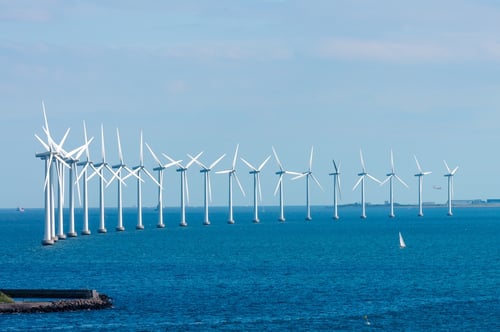New York State Will Deploy 2,400 MW of Offshore Wind Power by 2030

As we discussed in a previous article, offshore wind power has massive potential in the northeastern states. New York is committed to 50% renewable generation by 2030, and offshore wind power will contribute with 2,400 MW of planned capacity. The corresponding projects will be developed under the oversight of the NY State Public Service Commission.
NYSERDA will be receiving bids for the first 800 MW of offshore wind power by the end of 2018, announcing the winner during the second quarter of 2019. The process will be carried out in collaboration with the Long Island Power Authority and New York Power Authority, and a second solicitation is also planned for 2019.
Wind power has the potential to become a thriving industry in the state of New York, drawing an estimated investment of $6 billion over the following decades. To complement the growth of this industry, NYSERDA will conduct the following efforts:
- Investing $15 million in clean energy workforce training, and upgrading local infrastructure for the needs of the offshore wind industry.
- Leading the National Offshore Wind Research and Development Consortium,created with a public-private partnership and a $18.5 million grant from the US Department of Energy.
Find out how your building can benefit from renewable energy.
How Offshore Wind Power Will Benefit New York
The most evident benefit of wind power is delivering low-cost electricity with zero greenhouse gas emissions. Offshore wind power can contribute to both the renewable energy target and the emissions reduction target set by New York State.
- As mentioned above, the renewable energy target is 50% by 2030. It was established through a special law called the Renewable Portfolio Standard, which has been adopted in many other states. Note that the exact target is established by each state; for example, New Jersey aims for 22.5% renewable generation by 2021.
- The GHG emissions reduction target is 40% by 2030 and 80% by 2050, with respect to 1990 levels.
The 2,400 MW of offshore wind power will deliver enough electricity for 1.2 million New York households. These projects have the potential to create 5,000 new jobs in manufacturing, construction, operation and maintenance, where an estimated 2,000 jobs will be permanent. NYSERDA will include labor agreements and environmental requirements in contracts for offshore wind power projects, ensuring they are developed with social and environmental responsibility.

On Monday, June 23, NYSERDA held a conference to provide additional information and clarify doubts about the first 800 MW of offshore wind power. When analyzing the bids, they will focus 70% on price, 20% on economic benefits and 10% on project viability.
OREC: Offshore Wind Renewable Energy Certificates
In addition to selling electricity, offshore wind power developers will accumulate Offshore Wind Renewable Energy Certificates (OREC). Utility companies subject to the renewable energy target in the RPS law will be able to purchase ORECs, and this will count as credit towards the 50% goal.
- For project developers, ORECs represent an extra income beyond electricity sales.
- For utility companies, ORECs count toward the 50% renewable energy target. Instead of developing or purchasing the entire renewable generation capacity by themselves, these companies pay for ORECs.
NYSERDA will be serving as the OREC market, purchasing them from offshore wind power companies and reselling them to electric companies in the state.
- The OREC price will be negotiated on a 20- to 25-year term with the contract winners, and there will be both a fixed-price scheme and a variable indexed scheme.
- For contracts awarded with the variable price option, the index will be reviewed on a monthly basis.
Fixed price OREC sales provide a stable and predictable income for project developers. On the other hand, the variable price has the potential for extra income if the index increases, but also the risk of lower income if the index decreases.
Conclusion
New York’s wind power initiative will contribute to lower electricity prices, reduced emissions and job creation. Consider that there is already a successful solar incentive program called NY-Sun, and there are plans for large-scale deployment of energy storage systems. While solar and wind power contribute to making electricity more affordable, energy storage compensates for the variability of sunshine and wind.
In addition to the 2,400 MW of offshore wind power, the NY-Sun program will help develop over 3,000 MW of distributed solar power by 2022, and the NY Energy Storage Roadmap aims for 1,500 MW of storage capacity by 2025.

Michael Tobias
Michael Tobias, the Founding Principal of NY Engineers, currently leads a team of 150+ MEP/FP engineers and has led over 4,000 projects in the US
Join 15,000+ Fellow Architects and Contractors
Get expert engineering tips straight to your inbox. Subscribe to the NY Engineers Blog below.

